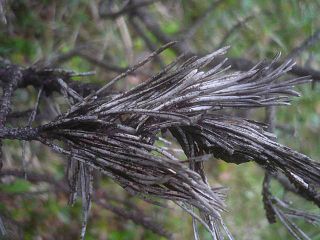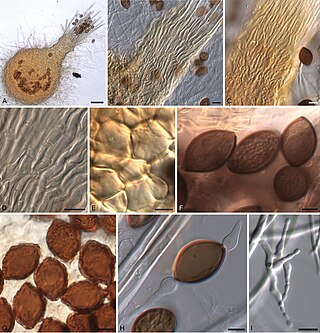
Herpotrichia is a genus of fungi in the family Melanommataceae.
Trabutia is a genus of fungi in the family Phyllachoraceae.

Venturia is a genus of fungi in the family Venturiaceae. First identified in 1882, species in the genus are plant pathogens. Venturia is widespread and the genus contains an estimated 58 species, or 130 species. Anamorphs were historically represented in the genus Fusicladium.
Hyponectria is a genus of fungi in the family Hyponectriaceae.

Paranectria is a genus of fungi in the class Sordariomycetes. It consisted of three species in 2008, in 2023 it had 8 species.
Massaria is a genus of fungi in the family Massariaceae.
Muyocopron is a genus of fungi in the Muyocopronaceae family.

Rutstroemia is a genus of fungi in the family Rutstroemiaceae. It was circumscribed by Petter Karsten in 1871.
Eriosphaeria is a genus of fungi in the family Trichosphaeriaceae. Species in this genus are plant pathogens.
Cercophora is a genus of fungi which was within the Lasiosphaeriaceae family. As of 2020, it was placed into the Neoschizotheciaceae family.
The Ceratostomataceae are a family of fungi in the phylum Ascomycota, class Sordariomycetes, subclass Hypocreomycetidae and order Coronophorales.

Apiospora is a genus of fungi which cause plant diseases. It gives its name to the family Apiosporaceae, which contains a number of other genera. This is historically a name for the teleomorph (sexual) life-cycle stage of the fungus; for some species the corresponding anamorph name is Arthrinium.
Myriangium is a genus of fungi within the family Myriangiaceae.

Melanospora is a genus of fungi within the Ceratostomataceae family.
Pseudomeliola is a genus of fungi in the Hypocreales order. The relationship of this taxon to other taxa within the order is unknown, and it has not yet been placed with certainty into any family. Unchanged in 2020.
Zignoëlla is a genus of fungi within the Chaetosphaeriaceae family.

The Torpedosporales are an order of marine based fungi in the class Sordariomycetes, subclass Hypocreomycetidae. Most are found on wood substrates in the water.
Etheirophoraceae is a family of ascomycetous marine based fungi within the order of Torpedosporales in the subclass Hypocreomycetidae and within the class Sordariomycetes. They are saprobic on intertidal wood and bark within marine habitats.

Juncigenaceae is a family of ascomycetous marine based fungi within the order of Torpedosporales in the subclass Hypocreomycetidae and within the class Sordariomycetes. They are saprobic to intertidal wood, within mangrove forests and other herbaceous wood and roots, bark, leaves in various marine habitats.
Torpedosporaceae is a monotypic family of ascomycetous marine based fungi within the order of Torpedosporales in the subclass Hypocreomycetidae and within the class Sordariomycetes. They are saprobic on intertidal mangrove wood and roots, bark leaves, and sand in various marine habitats.







